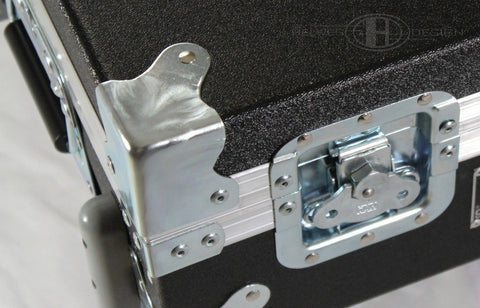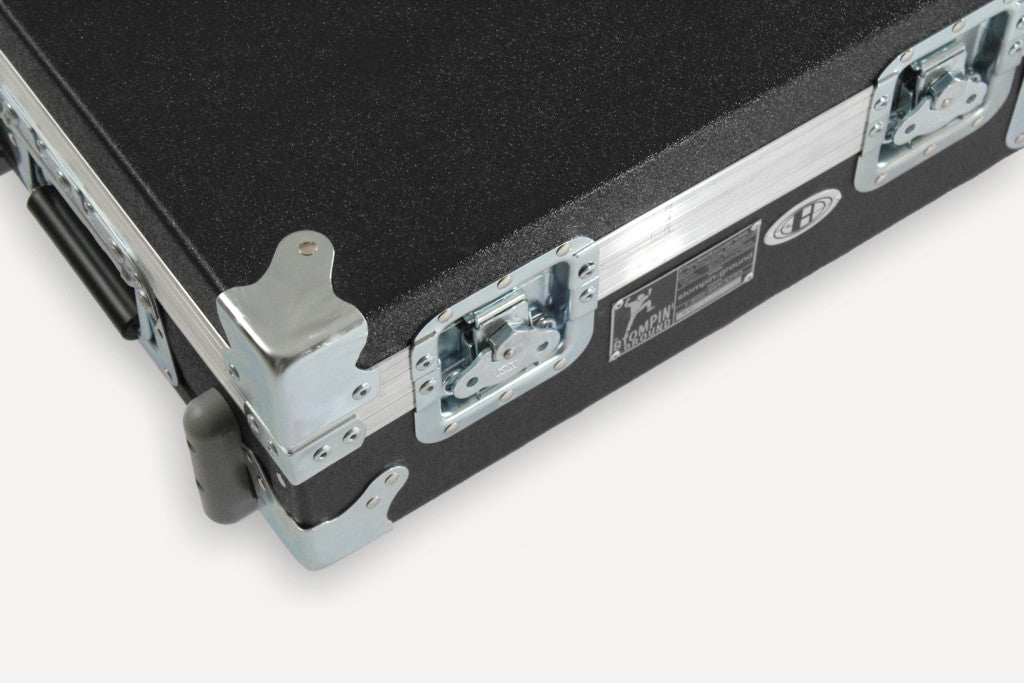Your Cart is Empty

In today’s post we tackle choosing a flight case: how to select the right features for your situation and things to consider when investing in a custom build.
As the name implies, a flight case is built to endure a harsh life of travel: being checked on flights, tossed on conveyor belts, and occasionally dropped off fork lifts. And through all of this, the high-dollar gear inside is completely unaware of the external beating taking place. You can use “road case” interchangeably here, as touring by truck, bus, or van calls for the same level of durability.
 Heavy-duty flight case with plywood construction.
Heavy-duty flight case with plywood construction.
The main body, or shell, is most commonly constructed of plywood panels joined with aluminum edging and steel corners. The plywood comes in a variety of thicknesses and is veneered with ABS plastic, shiny fiberglass, or occasionally aluminum or another industrial veneer. At a higher price point, you can replace the plywood with lighter-weight corrugated or foam-core panels. But expect to loose a little rigidity as you shed panel weight.
All of these shell and veneer options boast a much more durable surface than the fragile tolex covering on amplifiers and hard cases. Still, expect the case to collect scratches and wear. It’s going to take a beating; the goal here is that it lasts. If a case advertises a veneer or coating not mentioned above, make sure the product is a good equivalent (or has some added value). In my experience, any advantage of fiberglass and high-cost veneers over basic ABS is mainly cosmetic.

Plywood and corrugated ABS panels.

ABS and fiberglass veneers.
As important as the shell material—if not more important—is the hardware. Different styles of hinges, latches, lid stays, and handles withstand different levels of abuse. Educate yourself on the options by comparing several different case manufacturers or by browsing hardware on a supplier’s website such as this one: http://www.reliablehardware.com/

Be sure your case is built with enough hinges and latches for the size and weight of the case and its contents. Quality hardware is expensive. Cutting corners in this area is an easy way to lower pricing without many customers realizing what they are missing before it’s too late, so pay attention to the details.
I like full-length continuous piano-style hinges (shown left) as opposed to two or three individual hinges.
A good amount of the impact protection comes from a case’s inner foam padding. You will find quite a variety in foam style, density, and thickness on the market. Quality will again be a factor to consider, as cheap foam may fall apart or lose its springiness over time. Convoluted “egg carton” foam in the lid (shown right) is the best way to account for the variance in pedal heights and is especially important if your pedals are only held on by Velcro.
The foam’s perimeter will need a few strategic cutouts for hand access under the board when loading and unloading. Good communication with an experienced builder will help ensure details like this are done right the first time.

The terms “overbuilt” and “built like a tank” are used ad nauseam in gear reviews. It’s almost always meant as a positive feature but sometimes means the product is simply heavier than necessary.
As a pedalboard designer and builder, many of our clients consider weight a top concern. To shed a few pounds, pedals are stricken off rigs; giant boards are divided into manageable sizes; keyboardists are let go (okay, that may be a different problem). A large part of my job is keeping things as tight as possible without sacrificing functionality. If board weight is important, then case weight is equally so. While the thickest plywood and foam may offer the highest level of protection, even flight cases must remain portable. Balance is needed.
That’s where design comes in, selecting materials durable enough to get the job done without overbuilding. With all this in mind, I set out to fine-tune a flight case for our OpenWing 13 pedalboards.
I started with a great builder. Stompin’ Ground has been producing top-quality cases for decades, and we commission them with all our custom flight case builds. Troy (owner) pays great attention to design detail and was excited to help me work out specifications custom-tailored to the OpenWing 13 design.
I chose to go with the Duralight case. The shell is key to its construction, consisting of solid 1/8” thermoformed ABS. This sheds quite a bit of weight versus a plywood-and-aluminum construction. And I love the simplicity of the shell design. Troy and I found the Duralight a perfect match for the medium two-row OpenWing 13 boards.
Having chosen the shell type, I selected a suite of hardware upgrades to ratchet up reliability, portability, and convenience. I liked the recessed twist latches and spring-loaded recessed handles, which keep the hardware from being caught or damaged on other cases and luggage. Recessed parts require slightly thicker-than-standard foam padding, which seemed just right.
We decided to make tilt-wheels standard on the Deluxe model as well. This means you lift the case’s full weight only in and out of a vehicle, wheeling it the rest of the way. Cases for pedalboards up to 32” also get a robust extension handle. No more crouching over while speeding to the baggage check-in. All Stompin’ Ground cases feature a full-length nickel-plated steel hinge (mentioned above) and lid stays.


Finally, we included an under-the-board storage compartment for cables and tools. We added a compartment divider in cases for longer boards to further protect stashed gear. Oh, and being me, I requested the shells in custom black. We hope you like the Deluxe Duralight Case as much as we do. You can check out the full specs and features in the Product Page.

Comments will be approved before showing up.
